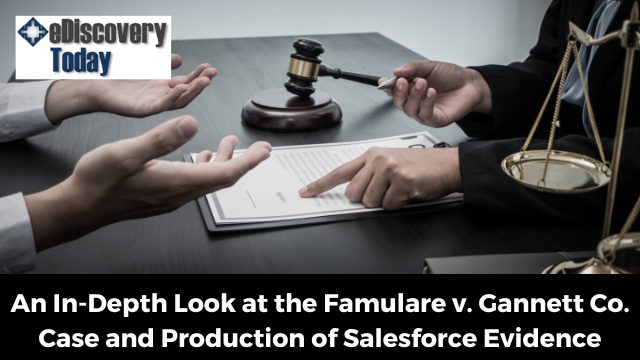
One of the great things about all the cases I cover on eDiscovery Today is that we proceed to discuss them within the month on the EDRM monthly case law webinar that I moderate with excellent observations from Tom O’Connor (Director of the Gulf Legal Technology Center), Mary Mack (CEO and Chief Legal Technologist of EDRM) and Hon. Andrew Peck (Ret.), Senior Counsel at DLA Piper.
While my coverage of these cases on my blog is a summary of what happened with a link to the case law ruling, our discussion on the webinar is a chance to “Monday Morning Quarterback” what the parties and the Court did and discuss what we can learn from the case. Often, we point out mistakes we feel the parties made (or question what they were even thinking) and sometimes, we point out mistakes we feel the Court made. Even Judge Peck doesn’t always agree with a judge’s ruling in every case.
I would say that Judge Martini was neither shaken nor stirred by the arguments…
The Hon. Andrew Peck (rET.)
Last month’s webinar had several terrific and interesting cases that we discussed, and it had a lot of interest from the audience in terms of questions and comments as well. One of the cases we discussed was Famulare v. Gannett Co., which addressed form of production out of the popular CRM platform Salesforce. Let’s take an in-depth look at the case here.
Famulare v. Gannett Co.
In this case (details and link to full ruling here on eDiscovery Today), New Jersey District Judge William J. Martini, finding that “Defendants have not persuaded this Court that the December 6, 2021 text order is clearly erroneous, contrary to law, or an abuse of Judge Hammer’s discretion” denied the defendants’ appeal of Magistrate Judge Michael Hammer’s order for the defendants to produce screenshots of Salesforce data from the defendant’s online Salesforce database or submit to a Rule 30(b)(6) deposition of a defendant representative if it maintained it could not produce the screenshot format.
The defendants had previously produced a spreadsheet instead of the screenshots requested by the plaintiff and their appeal was based on the grounds that it required them to produce ESI in a second format in contravention of FRCP 34(b)(2)(E)(iii), which states “A party need not produce the same electronically stored information in more than one form”.
What was interesting about this case is that the comments I received about it on my blog and social media posts were divided: some agreed with the ruling, while others thought the defendants shouldn’t be ordered to provide a second production. Some people also wondered if the defendants could even produce the screenshots the plaintiff was requesting.
With that in mind, I asked Mary about the fact that screen shots in Salesforce are a dynamic representation of data at a given point in time and whether she thought the defendants could even do what the plaintiff is asking for; if not, how could they have explained that better to the court?
Mary joked that “because we’re talking about a point in time, we’d need to have a DeLorean to get us back there to generate a screenshot of the Salesforce dashboard”. Noting that “the underlying spreadsheet data could generate graphs that would approximate what was seen in the screenshots”, Mary also stated: “[here’s] a couple of things about Salesforce. You’ve got list of salespeople, contacts, activities, dollar amounts, opportunities, the age of the opportunities, the disposition of the opportunities – and all of that changes every single day. Licenses cost money. So, if salespeople leave, those salespeople will probably be taken out of the graph territories and accounts change over time as well. Whether you could generate a dynamic point in time dashboard, I think they’d be arguing over whether it was authentic or not, and more than likely, a pivot table [in the spreadsheet] could give them the visuals they wanted.” Which is why, Mary said, “they could have done the depo”.
I asked Tom if he was surprised that the defendants didn’t submit to a 30(b)(6) deposition to state their position since Judge Hammer encouraged them to do so.
Tom stated: “it’s a head scratcher because not only did the judge encourage them to, but they indicated that they’d be happy to participate in such at one point in time”. But Tom also noted that “maybe that they thought they had a good argument under Rule 34(b)(2)(E)(iii), and so therefore, they wouldn’t need to because they were going to defeat any attempt” to be required to produce the screenshots. As Tom said, “Obviously, in retrospect, that was not a good assessment, but honestly, what they were thinking is a real head scratcher to me here.”
That left it to Judge Peck, to whom I asked whether the defendants have a point when they say they already produced the evidence once and can’t be forced to do so in a different form under Rule 34(b)(2)(E)(iii) as well as whether production of the data in a spreadsheet sufficient for producing it in the form in which it’s maintained?
Judge Peck, after noting the obvious pun that I missed (much to my dismay) that “I would say that Judge Martini was neither shaken nor stirred by the arguments”, stated: “the ‘only produce it once’ rule in Rule 34 is dependent on the document request and whether it sought a particular form of production. So, if the plaintiff said: ‘I want this information about comparator salespeople in this sort of form’, then the defendant must produce it in that form or state in its response ‘no, I’m not going to do what you’ve asked for, and I’m going to do something else.’” Judge Peck also stated: “it should have gone to the court before there was any production, so it would not have triggered the I only have to produce at once” consideration, noting “I am not particularly knowledgeable about Salesforce, but I doubt that the information is really kept in a spreadsheet form. So that is probably not the form in which the data is ordinarily maintained.” Judge Peck also discussed the defendants’ poor handling of the arguments, stating: “as the court pointed out, the conflicting arguments being made by the defendant did not put them in good stead. They’re arguing that this would be a second form of production which is verboten, but they’re also saying it’s not possible to do it in this way.”
Famulare v. Gannett Co. was an interesting case to discuss, and you can catch our full discussion of it and the other interesting May 2022 cases here. This case is also an example of how much we’re seeing screenshots as evidence requested and/or produced in discovery today; in fact, Tom has already found another case involving the admissibility of social media screenshots. Look for coverage of that case soon on eDiscovery Today and discussion of it on an upcoming EDRM case law webinar!
Experience more of Doug Austin’s great work at the eDiscovery Today blog here.
Follow Doug Austin on JD Supra here.
Follow EDRM on JD Supra here.


